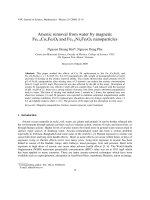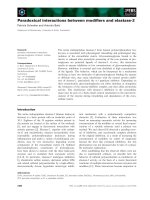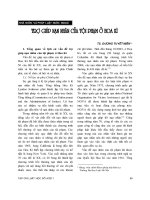Tài liệu Báo cáo "Arsenic removal from water by magnetic Fe1-xCoxFe2O4 and Fe1-yNiyFe2O4 nanoparticles " pptx
Bạn đang xem bản rút gọn của tài liệu. Xem và tải ngay bản đầy đủ của tài liệu tại đây (199.58 KB, 5 trang )
VNU Journal of Science, Mathematics - Physics 25 (2009) 15-19
15
Arsenic removal from water by magnetic
Fe
1-x
Co
x
Fe
2
O
4
and Fe
1-y
Ni
y
Fe
2
O
4
nanoparticles
Nguyen Hoang Hai*, Nguyen Dang Phu
Center for Materials Science, Faculty of Physics, College of Science, VNU
334 Nguyen Trai, Hanoi, Vietnam
Received 12 March 2009
Absrtact. This paper studied the effects of Co, Ni replacement in the Fe
1-x
Co
x
Fe
2
O
4
and
Fe
1-y
Ni
y
Fe
2
O
4
(x, y = 0, 0.05, 0.1, 0.2, 0.5) nanoparticles, pH, weight of nanoparticles/ml of water
and time of stirring on the arsenic removal ability. The results showed that small amount of 0.25
g/l of Fe
3
O
4
nanoparticles after stirring time of 3 minutes can reduce the arsenic concentration
from 0.1 mg/l to 0.01 mg/l. The removal was also affected by the pH of the water. Absorption of
arsenic by nanoparticles was effective when pH was smaller than 7 and reduced with the increase
of pH. At pH of 13, there was a strong release of arsenic ions from arsenic-absorbed nanoparticles
back to water. The time of stirring was studied from 1 minute to 2 hours, the optimal time was
about few minutes. Co and Ni presence was reported to maintain saturation magnetization stable
under working conditions. For Co replacement, absorption does not change significantly when x ≤
0.1 and slightly reduces when x > 0.1. The presence of Ni improved the absorption in most cases.
Keywords: Magnetic nanoparticles, ferrites, arsenic removal, water treatment.
1. Introduction
Arsenic occurs naturally in rocks, soil, water, air, plants and animals. It can be further released into
the environment through natural activities such as volcanic action, erosion of rocks and forest fires, or
through human actions. Higher levels of arsenic tend to be found more in ground water sources than in
surface water sources of drinking water. Arsenic-contaminated water has been a serious problem
especially in Vietnam, Bangladesh and some areas in the world [1, 2]. Human exposure to arsenic can
cause both short and long term health effects. Short or acute effects can occur within hours or days of
exposure. Long or chronic effects occur over many years. Long term exposure to arsenic has been
linked to cancer of the bladder, lungs, skin, kidneys, nasal passages, liver and prostate. Short term
exposure to high doses of arsenic can cause other adverse health effects [3, 4]. The World Health
Organization (WHO) maximum permissible concentration (MPC) value was set as 0.01 mg/l which
has been applied in many countries. There are many arsenic-removal techniques which have been
available such as coprecipitation, adsorption in fixed-bed filters, membrane filtration, anion exchange,
______
*
Corresponding author. Tel.: (84-4) 35582216
E-mail:
N.H. Hai, N.D. Phu / VNU Journal of Science, Mathematics - Physics 25 (2009) 15-19
16
electrocoagulation, and reverse osmosis [5, 6]. Iron oxides have been reported to have a high affinity
for the adsorption of arsenic and arsenate [7-9] due to the ability to form inner-sphere bidentate-
binuclear complexes with iron oxides [10-11]. Iron oxide nanoparticles with large surface area are
promising for arsenic removal. Some researches have been paid to study the effects of environment on
arsenic adsorption ability of magnetite Fe
3
O
4
nanoparticles [9, 12]. Magnetite nanoparticles have
highest saturation magnetization of 90 emu/g among iron oxides. Therefore, magnetite nanoparticles
can be used to adsorb arsenic ions followed by magnetic decantation. Other iron oxides and
hydroxides have been reported to have arsenic ability. However, magnetic properties of these
compounds are much less than that of magnetite. Oxidation of magnetite which resulted to the reduce
of the saturation magnetization was found. In a research of our group reported that replacement of Fe
2+
in Fe
3
O
4
by a small amount of Co
2+
or Ni
2+
can improve the oxidation resistance of the compound
[14]. Oxidation resistance is an important factor for arsenic removal under atmospheric conditions. In
this paper, we studied arsenic adsorption ability of Fe
1-x
Co
x
Fe
2
O
4
(Co-ferrites) and Fe
1-y
Ni
y
Fe
2
O
4
(Ni-
ferrites) (x, y = 0, 0.05, 0.1, 0.2, 0.5) nanoparticles.
2. Materials and methods
Magnetite particles with size of 15 nm were prepared by conventional coprecipitation of Fe
3+
and
Fe
2+
ions by OH
−
at room temperature. In a typical synthesis, 4.17 g of FeCl
3
.6H
2
O and 1.52 g of
FeCl
2
.4H
2
O (such that Fe
3+
/Fe
2+
=2) were dissolved in 80 ml water (concentration of Fe
2+
is 0.1 M)
with vigorous stirring. A solution of 6 ml NH
4
OH 35% was added with the rate of 1 drop per second at
room temperature during constant stirring. Black precipitates of Fe
3
O
4
(FeO.Fe
2
O
3
) were formed and
isolated from the solvent by magnetic decantation. Water washing and decantation process were
repeated four times to remove excess solution. By a similar way, Fe
1−x
Ni
x
O.Fe
2
O
3
and Fe
1−y
Co
y
.Fe
2
O
3
with x = 0.05, 0.1, 0.2, 0.5 and y = 0.2, 0.4 nanoparticles were made by replacing Fe
2+
by Ni
2+
and
Co
2+
using NiCl
2
.6H
2
O and CoCl
2
.6H
2
O, respectively. All procedures were conducted under N
2
atmosphere. Electron Transmission Microscope (TEM) JEM1010-JEOL was used to determine
particle size. The structure was examined by X-ray diffractometer (XRD) D5005, Bruker, using Cu-K
α
radiation. Magnetic properties were measured by Vibrating Sample Magnetometer DMS 880-CTS.
Arsenic solution (0.1 mg/l of As
3+
) was obtained by dissolving As
2
O
3
in doubly distilled improve the
oxidation resistance of the compound [16]. Oxidation resistance is an important factor for arsenic
removal under atmospheric conditions. In this paper, we studied arsenic adsorption ability of Fe
1-
x
Co
x
Fe
2
O
4
(Co-ferrites) and Fe
1-y
Ni
y
Fe
2
O
4
(Ni-ferrites) (x, y = 0, 0.05, 0.1, 0.2, 0.5) nanoparticles.
3. Results and discussion
Figure 1 presents the TEM image of the Fe
3
O
4
nanoparticles with particle size of 10 – 16 nm. The
particles were almost spherical and low size dispersity. The mean particle size was estimated to be
13.3 ± 3.1 nm. The surface area of 77.9 m
2
/g was calculated for magnetite sample from the mean
particle and magnetite density (5.18 g/cm
3
). XRD patterns of magnetite, Co-ferrites (Fig. 2) and Ni-
ferrites (not shown) revealed that the particles have the invert spinel crystalline structure as in the bulk
phase. The presence of Co
2+
and Ni
2+
ions did not change the particle size and reflection peaks
significantly. The field dependence of magnetization showed that all samples were superparamagnetic
at room temperature. In inverse spinel magnetite, a half of Fe
3+
ions locate at A sites and the half of
N.H. Hai, N.D. Phu / VNU Journal of Science, Mathematics - Physics 25 (2009) 15-19
17
them together with the divalent Fe
2+
ions locate at B sites. The Co
2+
and Ni
2+
ions prefer to replace at
B sites. Therefore, the orientation of spins is as followings:
−++
−
++
2
4
32
x1
2
x
3
OFeFeCoFe
−++
−
++
2
4
32
1
23
OFeFeNiFe
yy
According to Neel theory [15] saturation magnetization for a formula unit of the Co- and Ni-ferrites
can be determined by:
B
ferriteCo
s
xM
µ
)24( −=
−
B
ferriteNi
s
yM
µ
)4( −=
−
Magnetic moment of Ni
2+
and Co
2+
ions is 2
B
µ
and 3
B
µ
, respectively. As a result, the saturation
of magnetization of the Co- and Ni-ferrites linearly reduces with x and y. Figure 3 presents the
saturation magnetization as a function of Co and Ni content. A linear dependence was found in the
samples with the Co and Ni content lower than 0.5. At the higher content (x, y = 0.5), the Co and Ni
atoms can also place at A sites which resulted in the deviation from the linear dependence.
Arsenic adsorption ability of magnetite, Co- and Ni-ferrites was studied with different conditions
of stirring time, concentration of nanoparticles, and pH. Table 1 shows the stirring time dependence of
arsenic removal of 1 g/l of Co-ferrites at neutral pH. The starting concentration of 0.1 mg/l was
reduced about 10 times down to the MPC value of 10 µg/l after stirring time of few minutes. The
removal process did not seem to depend significantly on the concentration of x in the Co-ferrites.
Similar results were found for the Ni-ferrites, in which arsenic concentration was reduced to the MPC
value after few minutes of stirring and the removal did not change significantly with y. We also
studied the effects of the weight of nanoparticles on the removal process The stirring time was fixed to
be 3 minutes and the weight of samples was changed from 0.25 g/l to 1.5 g/l with step of 0.25 g/l. The
results showed that, after 3 minutes, the optimal weight to reduce arsenic concentration down to the
value lower than the MPC was 0.25 g/l for magnetite and 0.5 g/l for Co- and Ni-ferrites.
Fig. 1. TEM image of the Fe
3
O
4
nanoparticles.
20 30 40 50 60 70 80
0
100
200
300
400
x = 0.5
x = 0.2
x = 0.1
x = 0.05
Intensity (a.u.)
2θ (degree)
x = 0
Fig. 2. XRD patterns of the magnetite nanoparticles.
N.H. Hai, N.D. Phu / VNU Journal of Science, Mathematics - Physics 25 (2009) 15-19
18
The arsenic adsorption was reported to be independent of pH in the range of 4 to 10. However, at
high pH value, the adsorption reduced significantly. Arsenic was desorbed from the adsorbent at
alkaline pH [9]. Our reported results were conducted at pH of 7. After arsenic adsorption, the
nanoparticles were stirred under pH of 13 to study the desorption process. Nanoparticles were
collected by a magnet and arsenic concentration in the solution was determined by AAS. Results
showed that 90% of arsenic was desorbed from nanoparticles. The nanoparticles after desorption did
not show any difference in arsenic re-adsorption ability. The adsorption-desorption process was
repeated 4 times, which proved that the nanoparticles can be reused for arsenic removal.
Table 1. Arsenic concentration (µg/l) remained in water after removal by 1 g/l of the Co-ferrites as a function of
the stirring time
Time (min) x = 0.05 x = 0.1 x = 0.2 x = 0.5
1 10 11 6 6.5
3 6 5 8.5 7
7 10 9 4.2 7.8
15 9 12 5 6.9
30 12 4.5 5 11.2
60 4.5 5 8 9.8
4. Conclusion
The presence of Co
2+
and Ni
2+
in Fe
1-x
Co
x
Fe
2
O
4
and Fe
1-y
Ni
y
Fe
2
O
4
with oxidation resistance did
not change significantly arsenic adsorption ability. With small amount of the materials, simple
preparation, we could reduce arsenic concentration to the value lower than MPC.
Acknowledgments. The authors would like to thank the Asia Research Center, Vietnam National
University, Hanoi (DT 34/2007/HD-DT) for finance support.
0.0 0.1 0.2 0.3 0.4 0.5
40
50
60
70
80
M
s
(emu/g)
x, y
Ni-ferrite
Co-ferrite
Fig. 3. Saturation magnetization of the Co- and Ni-ferrite as a function of Co
2+
(x) and Ni
2+
(y) content.
N.H. Hai, N.D. Phu / VNU Journal of Science, Mathematics - Physics 25 (2009) 15-19
19
References
[1]
[2] M. Bissen, F.H. Frimmel, Arsenic–A review. Part I: Occurrence, toxicity, speciation, mobility, Acta
Hydroch. Hydrob. 31 (2003) 9.
[3] L.C.D. Anderson, K.W. Bruland, Biogeochemistry of arsenic in natural waters: The importance of
methylated species, Environ. Sci. Technol. 25 (1991) 420.
[4] W.P. Tseng, H.M. Chu, S.W. How, J M. Fong, C.S. Lin, S. Yeh, Prevalence of skin cancer in an endemic
area of chronic arsenicism in Taiwan, J. Nat. Cancer Inst. 40 (1968) 453.
[5] L.G. Twidwell, J. McCloskey, P. Miranda, M. Gale, Technologies and potential technologies for removing
arsenic from process and mine wastewater, in Proceedings global symposium on recycling, waste treatment
and clean technology, Ed. I. Gaballah, J. Hager, R. Solozabal, Warrendale, PA. (1999) 1715.
[6] M. Bissen, F.H. Frimmel, Arsenic–A review. Part II: Oxidation of arsenic and its removal in water treatment,
Acta Hydroch. Hydrob. 31 (2003) 97.
[7] M.L. Pierce and C.B. Moore, Adsorption of arsenite and arsenate on amorphous iron hydroxide, Water Res.
15 (1982) 1247.
[8] K.P. Raven, A. Jain, R.H. Loeppert, Arsenite and arsenate adsorption on ferrihydrite: Kinetics, equilibrium,
and adsorption envelopes, Environ. Sci. Technol. 32 (1998) 344.
[9] S. Yean, L. Cong, C.T. Yavuz, J.T. Mayo, W.W. Yu, A.T. Kan, V.L. Colvin, M.B. Tomson, Effect of
magnetite particle size on adsorption and desorption of arsenite and arsenate, J. Mater. Res., 20 (2005) 3255.
[10] S. Fendorf, M.J. Eick, P. Grossl, Arsenate and chromate retention mechanisms on goethite Surface
structure, Environ. Sci. Technol. 31 (1997) 315.
[11] A. Manceau, The mechanism of anion adsorption on ironoxides-Evidence for the bonding of arsenate
tetrahedra on free Fe(O,OH)(6) edges, Geochim. Cosmochim, Acta 59 (1995) 3647.
[12] X.H. Sun, H.E. Doner, An investigation of arsenate and arsenite bonding structure on goethite by FTIR, Soil
Sci. 161 (1996) 865.
[13] G.A. Waychunas, B.A. Rea, C.C. Fuller, J.A. Davis, Surface chemistry of ferrihydrite, Part l. EXAFS
studies of the geometry of coprecipitated and adsorbed arsenate. Geochim. Cosmochim, Acta 57 (1993)
2251.
[14] N.H. Hai, N.D. Phu, N. Chau, H.D. Chinh, L.H. Hoang, D.L. Leslie-Pelecky, Mechanism for Sustainable
Magnetic Nanoparticles under Ambient Conditions, J. Korean Phys. Soc. 52 (2007) 1327.
[15] L. Neel, Ann. de Phys. 3 (1948) 137.









